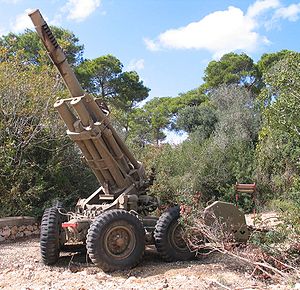Loading AI tools
Field howitzer From Wikipedia, the free encyclopedia
Obusier de 155 mm Modèle 50 was a French 155 mm 30 calibre howitzer introduced in 1952.[2] The first French artillery designed since World War II, it was manufactured in both France - 980 howitzers were produced (French army and export) - and under license in Sweden for the Swedish armed forces. The Model 50 was replaced in French service during the 1980s by the TRF1.[2] Reserve units were produced until the end of the 1990s.[3]
| Obusier de 155 mm Modèle 50 | |
|---|---|
 Obusier de 155 mm Modèle 50 in Beyt ha-Totchan Museum, Zikhron Ya'akov. | |
| Type | Field howitzer |
| Place of origin | France |
| Service history | |
| In service | 1952-1990s |
| Used by | See Operators |
| Specifications | |
| Mass | 8,100 kg (17,900 lb) |
| Length | 7.8 m (25 ft 7 in)[1] |
| Barrel length | 4.65 m (15 ft 3 in) L/30 |
| Width | 2.7 m (8 ft 10 in)[1] |
| Height | 2.5 m (8 ft 2 in)[1] |
| Crew | 11[1] |
| Shell | Separate loading charge and projectile[1] |
| Caliber | 155 mm (6.1 in) |
| Breech | interrupted screw |
| Recoil | Hydro-pneumatic[1] |
| Carriage | Split trail |
| Elevation | -4°/69° |
| Traverse | 80° |
| Rate of fire | 3-4 rpm[1] |
| Muzzle velocity | 650 m/s (2,100 ft/s) |
| Effective firing range | 18,000 m (20,000 yd) |
| Maximum firing range | 23,300 m (25,500 yd) |

The Model 50 has a split trail, large slotted muzzle-brake, four-wheeled bogie and a retractable firing pedestal beneath the axles.

Seamless Wikipedia browsing. On steroids.
Every time you click a link to Wikipedia, Wiktionary or Wikiquote in your browser's search results, it will show the modern Wikiwand interface.
Wikiwand extension is a five stars, simple, with minimum permission required to keep your browsing private, safe and transparent.